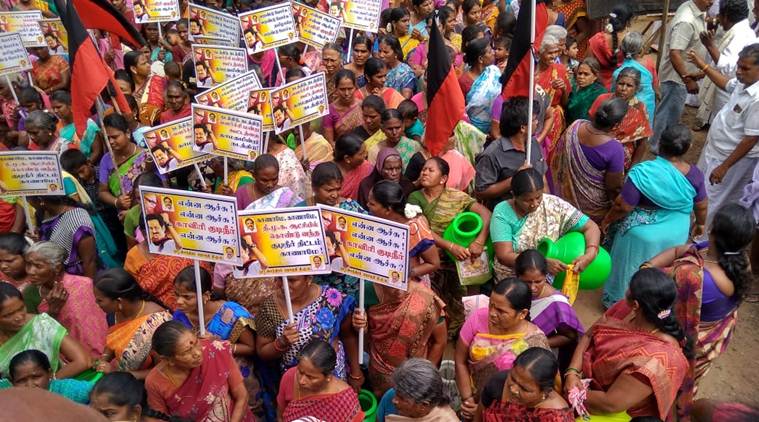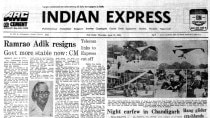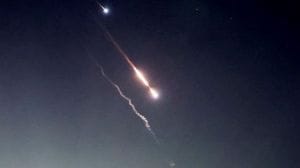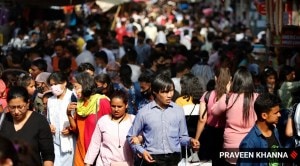- India
- International
A world without water
Chennai is parched. So is Tamil Nadu. Women of already water-stressed districts like Virudhunagar and Ramanathapuram have to walk several kilometres daily to fetch water. The walks offer no assurance of the availability of water.
 Chennai is parched. So is Tamil Nadu. Women of already water-stressed districts like Virudhunagar and Ramanathapuram have to walk several kilometres daily to fetch water. (Twitter/@DMKDindigul)
Chennai is parched. So is Tamil Nadu. Women of already water-stressed districts like Virudhunagar and Ramanathapuram have to walk several kilometres daily to fetch water. (Twitter/@DMKDindigul)
Written by G Sundarrajan
Around 2,000 years ago, in his immense and matchless wisdom, the sage-poet Thiruvalluvar said there was no world without water, Neer indri amaiyathu ulagu. Today, even as Chennai has come to the streets searching for water, the words shine a light on the immortality of the truth yet again.
Chennai is parched. So is Tamil Nadu. Women of already water-stressed districts like Virudhunagar and Ramanathapuram have to walk several kilometres daily to fetch water. The walks offer no assurance of the availability of water. On many days, they have to do without the “luxury”. Temporary wells have been dug in several villages in and around these districts for the poor to access some water. Early this March, the state government declared 24 districts as hit by hydrological drought, and allotted close to Rs 900 crore to handle the scarcity. That has not seen an end to women walking miles looking for water. Nor has it ended the midnight queues next to water tanks in Chennai.
Though the entire state is reeling under a debilitating water crisis, the focus is largely on Chennai. The state capital has a population of about a crore — the density making it enormously difficult to handle the crisis. The four reservoirs in and around Chennai — Red Hills, Sholavaram, Poondi and Chembarambakkam — have completely dried up. The four reservoirs were essential to quench the city’s thirst. Not so long ago, in 2015, Chembaram-bakkam had filled up and the overflow had flooded Chennai. But the flood that brought the city’s residents to the streets is now a distant, fading memory for those who have returned to the streets, this time to demand water.
As an environmentalist, I have reasons to believe that this drought is the result of human follies. Chennai has seen some rain-deficient years in the past. While it received less rainfall last year than usual, it could still manage the drought. So, to blame low rainfall is clearly an attempt by the authorities to pass the buck. Such excuses offer a convenient blindfold against actual solutions. The crisis Chennai is currently facing is drought-accumulation stress: in other words, our own failure to take concrete steps over the the past decades. Several of us saw this coming. Chennai’s water need is about 12 TMC (thousand million cubic feet) per year and desilting all the four reservoirs would take its capacity to well over the city’s requirements. That has not happened!

Chennai has lost over 350 lakes in the past several years. Over the years, Chennai has also lost its green cover which, in turn, has led to the loss of groundwater. With no path for rainwater to seep down, Chennai is facing the danger of exploiting all its groundwater by 2020, according to a NITI Aayog report. This year, the groundwater level has gone down drastically in many districts, including Chennai, compounding the crisis.
It is perhaps time the state turned to ancient wisdom for solutions.
The Chola kingdom was particularly known for exemplary water management by way of constructing lakes. Kallanai constructed by the Chola king, Karikalan, remains a fine example of constructing a dam without causing environmental damage. Two lakes constructed by the Chola kings over a thousand years ago —in Maduranthakam and Veeranam — cater to the needs of the public till date.
Ancient Tamil literature, especially of the Sangam era, is replete with ideas on water management and its importance. Elango Adigal, the author of Silappadhikaram, one of the five great epics of Tamil, describes the qualities of a good king thus: Idiyudai perumazhai eitha ega pisiyaavilaiyul peruvalam tharappa mazhaipinithu aanda mannavan (A good king is one who saves rainwater in tanks and lakes, and enriches his land).
A poem from the Sangam-era anthology Akanaanooru compares a mother watching over her child without sleeping to a soldier guarding a lake: Perungula kaavalan pola arungadi annaiyum thuyil maranthanale. Another Sangam poem says that a king will remain victorious and immortal if he takes steps to ensure water resources in low-lying areas: Aadupor sezhiya igazhaathu valle nilaneli marungin neernilai peruga.
And, of course, Thirukkural speaks at length on the importance of water and its management.
When elders have handed down such priceless wisdom, it is ironic that our rulers think it fit to hold yagnas to propitiate the rain gods. Reports suggest that a permanent solution to the water woes of Chennai — and Tamil Nadu — lies with the monsoon. Metro water authorities are raving how only rain can solve this crisis. But that is only half-truth. It is our ability to harvest rains for our own future needs that can address the crisis. During the December 2015 deluge in Chennai, 320 TMC water drained into the sea. Our consistent failure to harvest rainwater for our use and needs of future generations will only result in recurrent drought and eventually, a permanently parched Tamil Nadu.
Sundarrajan writes on ecology and volunteers with Poovulagin Nanbargal, a voluntary environmental collective in Tamil Nadu
Translated by the author from Tamil
EXPRESS OPINION
Must Read
More Explained
Apr 19: Latest News
- 01
- 02
- 03
- 04
- 05









































